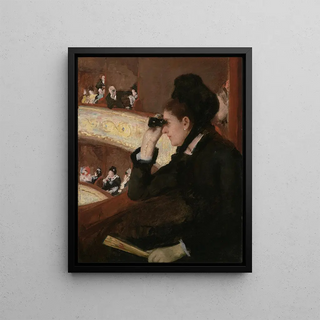Art print | In the dressing room - Mary Cassatt


View from behind

Frame (optional)
In the fascinating world of art, some works stand out for their ability to capture the essence of everyday life while offering a unique perspective on the human condition. "In the Dressing Room" by Mary Cassatt is one of those creations that transcends time and space. Created at the end of the 19th century, this canvas immerses us in the intimacy of a theater dressing room, where elegance and introspection intertwine. The scene, filled with subtlety, invites us to observe the social interactions of the era while revealing the artist's sensitivity to women's lives. Cassatt, a pioneer of the Impressionist movement, uses her art to explore female roles, making this piece a valuable testament to her time.
Style and uniqueness of the work
Mary Cassatt's style is characterized by delicate brushstrokes and a refined color palette, which give her works an intimate and warm atmosphere. In "In the Dressing Room," the composition is carefully orchestrated, highlighting the female figure at the center of the canvas. The play of light and shadow, as well as the meticulous details of the costumes, testify to the artist's attentive observation of her subject. Cassatt succeeds in creating an ambiance that is both dynamic and contemplative, where the viewer is invited to delve into the thoughts of the protagonist. The depiction of women, often preparing or contemplating the world around them, emphasizes their central role in society while highlighting their subjectivity. This work, through its technique and theme, stands out as an emblematic example of Cassatt's talent and her innovative approach.
The artist and her influence
Mary Cassatt, born in 1844 in Pittsburgh, is a key figure in Impressionist art, although often overshadowed by her male counterparts. Her career, marked by travels to Europe and collaborations with artists such as Edgar Degas, allowed her to develop a unique style that combines modernity and tradition. Cassatt primarily dedicated herself to depicting women and children, capturing moments of tenderness and complicity. Her influence extends beyond her era, as she

Matte finish

View from behind

Frame (optional)
In the fascinating world of art, some works stand out for their ability to capture the essence of everyday life while offering a unique perspective on the human condition. "In the Dressing Room" by Mary Cassatt is one of those creations that transcends time and space. Created at the end of the 19th century, this canvas immerses us in the intimacy of a theater dressing room, where elegance and introspection intertwine. The scene, filled with subtlety, invites us to observe the social interactions of the era while revealing the artist's sensitivity to women's lives. Cassatt, a pioneer of the Impressionist movement, uses her art to explore female roles, making this piece a valuable testament to her time.
Style and uniqueness of the work
Mary Cassatt's style is characterized by delicate brushstrokes and a refined color palette, which give her works an intimate and warm atmosphere. In "In the Dressing Room," the composition is carefully orchestrated, highlighting the female figure at the center of the canvas. The play of light and shadow, as well as the meticulous details of the costumes, testify to the artist's attentive observation of her subject. Cassatt succeeds in creating an ambiance that is both dynamic and contemplative, where the viewer is invited to delve into the thoughts of the protagonist. The depiction of women, often preparing or contemplating the world around them, emphasizes their central role in society while highlighting their subjectivity. This work, through its technique and theme, stands out as an emblematic example of Cassatt's talent and her innovative approach.
The artist and her influence
Mary Cassatt, born in 1844 in Pittsburgh, is a key figure in Impressionist art, although often overshadowed by her male counterparts. Her career, marked by travels to Europe and collaborations with artists such as Edgar Degas, allowed her to develop a unique style that combines modernity and tradition. Cassatt primarily dedicated herself to depicting women and children, capturing moments of tenderness and complicity. Her influence extends beyond her era, as she






